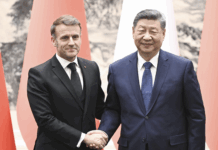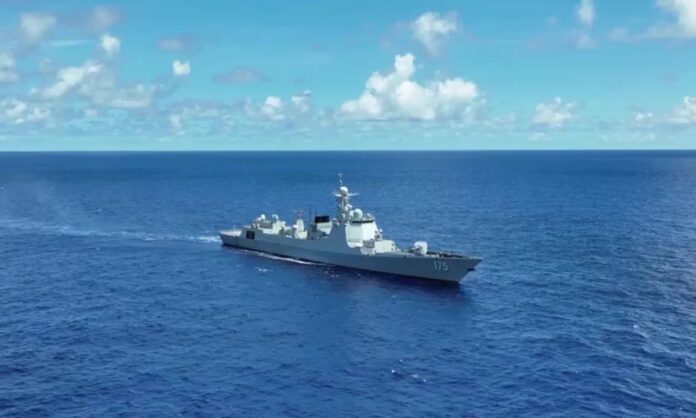BEIJING: Chinese and Russian navies recently wrapped up a joint naval patrol that stretched from northern Pacific waters to the South China Sea, meanwhile, the sea phase of a live-fire exercise between the two navies started, as experts expect the joint operations to enhance the two navies’ interoperability in dealing with maritime security threats.
The navies of China and Russia successfully wrapped up their fourth joint maritime patrol, China Central Television (CCTV) reported on Tuesday.
A China-Russia joint naval formation started the joint patrol in waters to the south of Jeju Island, made a transit through the Osumi Strait and sailed south through the West Pacific before entering the South China Sea via the Balintang Channel, CCTV reported.
Consisting of the Type 052D destroyer Yinchuan, Type 054A frigate Hengshui from the Chinese side and the corvette Sovershenny from the Russian side, the joint patrol formation practiced training courses including VBSS (visit, board, search and seizure) and helicopter cross-deck landing in the northern and western waters of the Pacific Ocean. China’s Type 903 comprehensive replenishment ship Weishanhu also joined the formation and provided replenishment during the patrol.
Sailors from the two navies worked closely, tacitly and efficiently and completed the scheduled missions, the report said.
In a concurrent event, the China-Russia Joint Sea-2024 exercise entered the sea phase after participating warships set out from the naval port in Zhanjiang, South China’s Guangdong Province on Monday, the Chinese People’s Liberation Army (PLA) Navy said in a release on Tuesday.
The China-Russia warship formation is scheduled to hold a three-day maritime exercise practicing live-fire training courses, including stationary defense, joint reconnaissance and early warning and joint search and rescue as well as joint air defense, the PLA South Sea Fleet said.
The joint formation for the exercise consists of the Type 052D destroyer Nanning, Type 054A frigates Xianning and Dali from the Chinese side, and the corvettes Gromkiy and Rezkiy as well as the Irkut oiler from the Russian side, according to the PLA Navy.
Since Zhanjiang, where the joint exercise started from, is a coastal city along the South China Sea, and the joint patrol also concluded in the South China Sea, it means that there are at least 10 Chinese and Russian warships operating in two joint formations simultaneously in the region, a Chinese military expert who requested anonymity told the Global Times on Tuesday.
Such joint naval activities will enhance the two navies’ interoperability and capability in tackling maritime security threats in the region, the expert said.
While the PLA Navy stressed that the China-Russia joint patrols do not target any third party and are not related to current international and regional situations, the AP said in a Monday report that the China-Russia naval cooperation came on the heels of “China’s latest tensions with NATO allies last week.”
Zhang Junshe, another Chinese military expert, told the Global Times that it is totally baseless to link the China-Russia naval cooperation to “confronting NATO.”
China and Russia have held multiple editions of Joint Sea exercises since 2012, and their joint maritime patrols were held four times since 2021, showing that such China-Russia joint naval operations are routine, observers said.
The two countries’ navies are practicing defense and rescue-oriented training courses that do not have strategic or operational implications, unlike the US-led RIMPAC exercise that blatantly set US’ competitors as imaginary enemies, Zhang said.






















